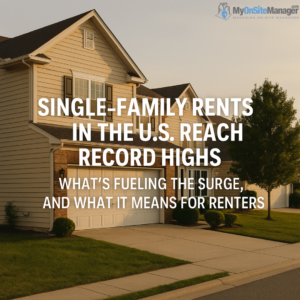The U.S. housing market continues to be shaped by unprecedented demand and economic shifts, and nowhere is this more evident than in the soaring costs of single-family rental homes. According to a new report by Zillow, the average rent for a single-family home has reached an all-time high of $2,179 per month, up 4.4% from the previous year. This milestone illustrates a deepening affordability crisis for American renters—and highlights the widening gap between single-family and multifamily rental markets.
Single-Family Rentals Outpace Apartments by a Wide Margin
One of the most eye-opening takeaways from the report is the premium that renters now pay for single-family homes. On average, renting a single-family residence costs $350 more per month than an apartment—representing a record 20% price gap. That gap has never been wider, underscoring just how scarce and in-demand detached rental homes have become.
Since the start of the pandemic, single-family rents have surged 41%, significantly outpacing the 26% growth seen in multifamily rents. This signals a clear shift in tenant preferences toward more spacious living environments—likely driven by hybrid work, lifestyle upgrades, and changes in household composition.
Supply Constraints Add Fuel to the Fire
According to Zillow Chief Economist Skylar Olsen, a key contributor to the rent surge is the supply shortage of single-family homes. While multifamily construction has ramped up to its highest levels in 50 years, the same cannot be said for standalone houses. Builders have focused on apartments, leaving a tight inventory of available single-family homes—especially in high-demand suburbs.
This imbalance between supply and demand has created fierce competition, pushing prices higher. In many urban and suburban markets, tenants are left with little choice but to pay the premium or settle for a smaller unit.
Millennials and Middle-Class Families Drive Demand
Demographic shifts are also playing a major role in reshaping the rental landscape. Millennials—now the largest adult generation in the U.S.—are entering life stages where larger living spaces are needed. However, high interest rates, steep down payments, and tighter lending standards have locked many would-be buyers out of homeownership.
As a result, an increasing number of families are renting the lifestyle they once planned to buy. In fact, Zillow reports that the median age of renters rose from 33 in 2021 to 42 in 2024, as older and more financially established adults remain in the rental pool longer than previous generations.
Regional Differences: Salt Lake City to Detroit
The rental premium for single-family homes varies widely across the country. In Salt Lake City, renters pay a staggering 59% more for a single-family home compared to an apartment. Meanwhile, in Detroit, the premium is a more modest 9%.
Some cities, like Pittsburgh, have mitigated rental disparities through an active pipeline of single-family home construction. The premium there is just 14%, showing that supply-side solutions can have a tangible impact on rental affordability.
The Rise of Rental Concessions
Interestingly, while single-family rents are climbing, multifamily landlords are beginning to offer more incentives to lure tenants. Zillow data shows that 41% of multifamily listings now include concessions such as free rent for the first month, waived application fees, or complimentary parking. That’s the highest share ever recorded on the platform, signaling softness in the apartment market even as overall demand remains high.
What This Means for the Future
The rapid rise in single-family rental prices highlights the deepening divide in housing access and affordability. Unless the supply of affordable single-family homes catches up with demand, these trends are likely to continue—putting more pressure on middle-income households.
For renters, this means carefully evaluating housing priorities, considering alternative locations, and negotiating concessions where possible. For policymakers and developers, the message is clear: expanding the inventory of family-sized rental homes is no longer just a market opportunity—it’s an economic necessity.
Final Thoughts:
Single-family homes offer comfort, privacy, and space—but for many Americans, those benefits are becoming increasingly out of reach. As we head deeper into 2025, the rental market will remain a crucial barometer of the nation’s housing health.
Source: Elite Agent – Single-family rents hit record high in US

